The dominance of the West in India spurred various forces, some as a direct consequence and others as a reaction, collectively challenging Western imperialism. In 1833, Lord Macaulay foresaw the transformative potential of his educational policy, envisioning an educated Indian demanding European institutions. New political ideas—nationalism and political rights—which were alien to India, were brought through the assimilation of Western culture. These political associations were a precursor to 19th century India’s entry into modern politics; the secular interests brought together the diverse classes in contrast to these past religious and caste groups. It was the first time people of different cultures were associated with the political scene in India and changed everything.
| “It may be that the public mind of India may expand under our system until it has outgrown that system, that by good government we may educate our subjects into a capacity for better government; that having become instructed in European language, they may, in some future age demand European institutions.”
– Lord Macaulay, in the course of a speech before the House of Commons |
Predecessors of the Indian National Congress
The Indian National Congress (INC) did not emerge as the first political organization in India, but it was the first organized expression of the Indian national movement on a pan-India scale. It had, however, many predecessors. In the first half of the nineteenth century, political associations were largely dominated by wealthy or aristocratic factions which were often local or regional.
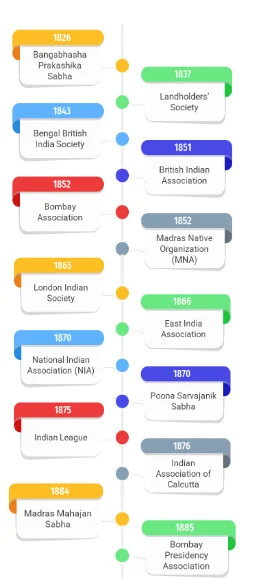
- Advocacy for Administrative Reforms: These groups vigorously approached the British Parliament, putting forth requests concerning administrative changes, association of the Indians with the administration, and the spread of education.
- Rise of the Educated Middle Class: In transitioning to the latter half of the nineteenth century, these political associations also experienced the supremacy of the educated middle class.
- Expansion of Political Leadership: This group comprised specialists including lawyers, journalists, doctors, and teachers, who adopted a more far-reaching approach (wider perspective).
- Growing Critique of British Policies: As educated Indians delved into the nature of British rule and its implications for India, their scrutiny led to an increasing level of criticism of British policies in the country.
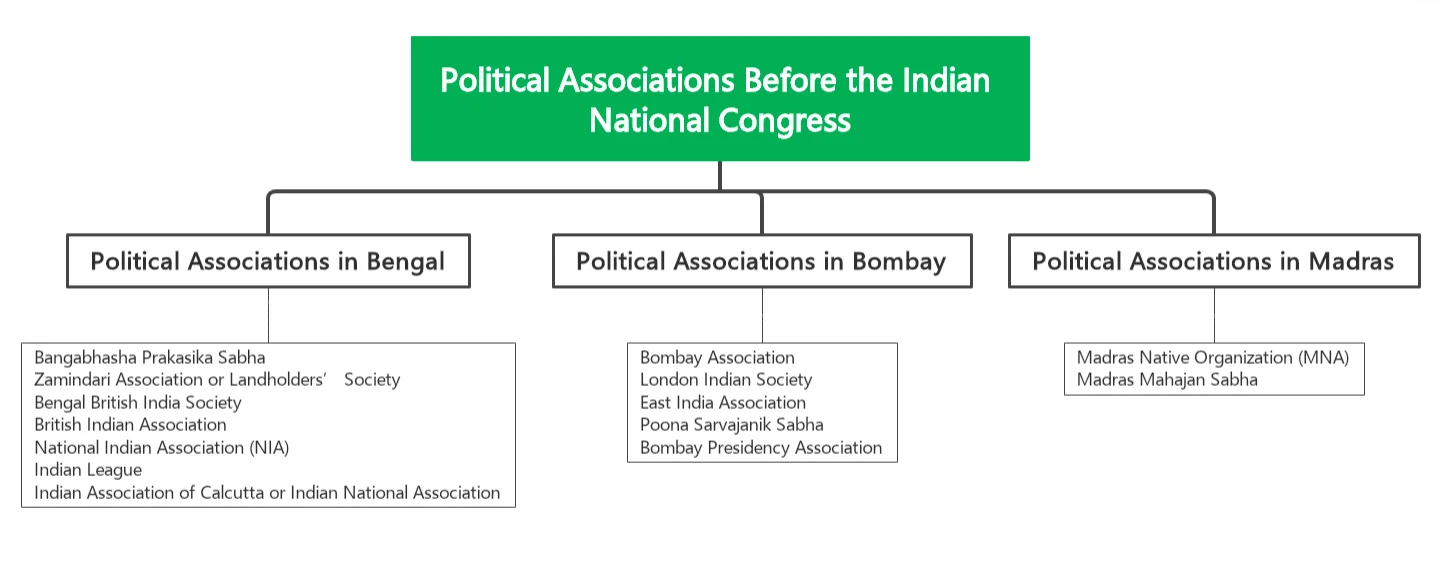
Political Organisation in Bengal
Raja Rammohan Roy, the leading figure in the political movement of the Bengal presidency was a highly intellectualized person whose philosophies were greatly influenced by the Western world. Contrary to the ordinary Bengali of his days, Rammohan Roy’s wide readings purged his head from bias.
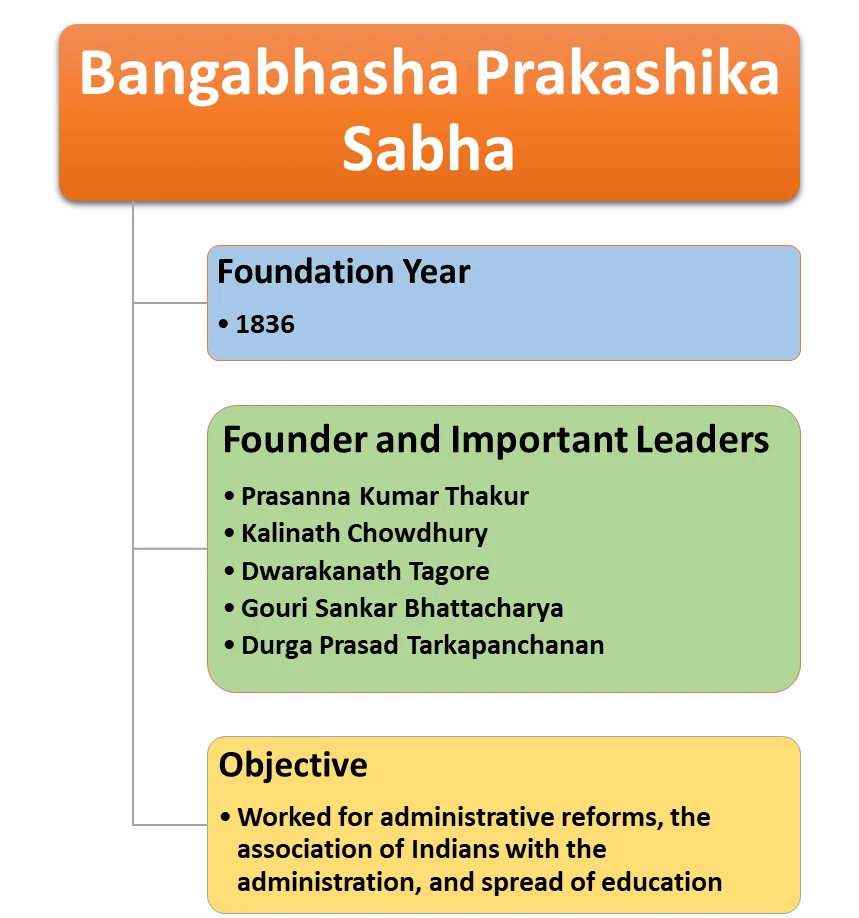
- His politics did not observe boundaries as he was sympathetic to popular movements around the globe.
- Constitutional Governance and Press Freedom: He celebrated the constitutional government of Spain in Calcutta in 1821. This is how Rammohan Roy became the first Indian to be noticed by the English among those who were complaining about India’s grievances on press freedom, Indian appointments in key positions, and even law codification.
- While he laid the groundwork, his associates formed the inaugural political association, the “Bangabhasha Prakasika Sabha,” in 1836.
Bangabhasha Prakashika Sabha(1836)
This organization was founded by Associates of Raja Rammohan Roy which included Prasanna Kumar Thakur, Kalinath Chowdhury, Dwarakanath Tagore, and others in 1836. Gouri Sankar Bhattacharya served as the president of the Sabha, while Durga Prasad Tarkapanchanan held the position of secretary.
Objectives
- The Sabha aimed to champion administrative reforms, advocate for increased Indian participation in the administration, and foster the dissemination of education.
- As a collective endeavor, this association became a platform for discussions and actions geared towards addressing pressing issues and shaping a transformative vision for the governance and educational landscape of the time.
Landholders’ Society
In the year 1837, Dwarkanath Tagore spearheaded the formation of the Landholders’ Society (also known as the Zamindari Association), joined by other influential members such as Radhakant Deb, Prasanna Kumar Tagore, Rajkamal Sen, and Bhabani Charan Mitra.
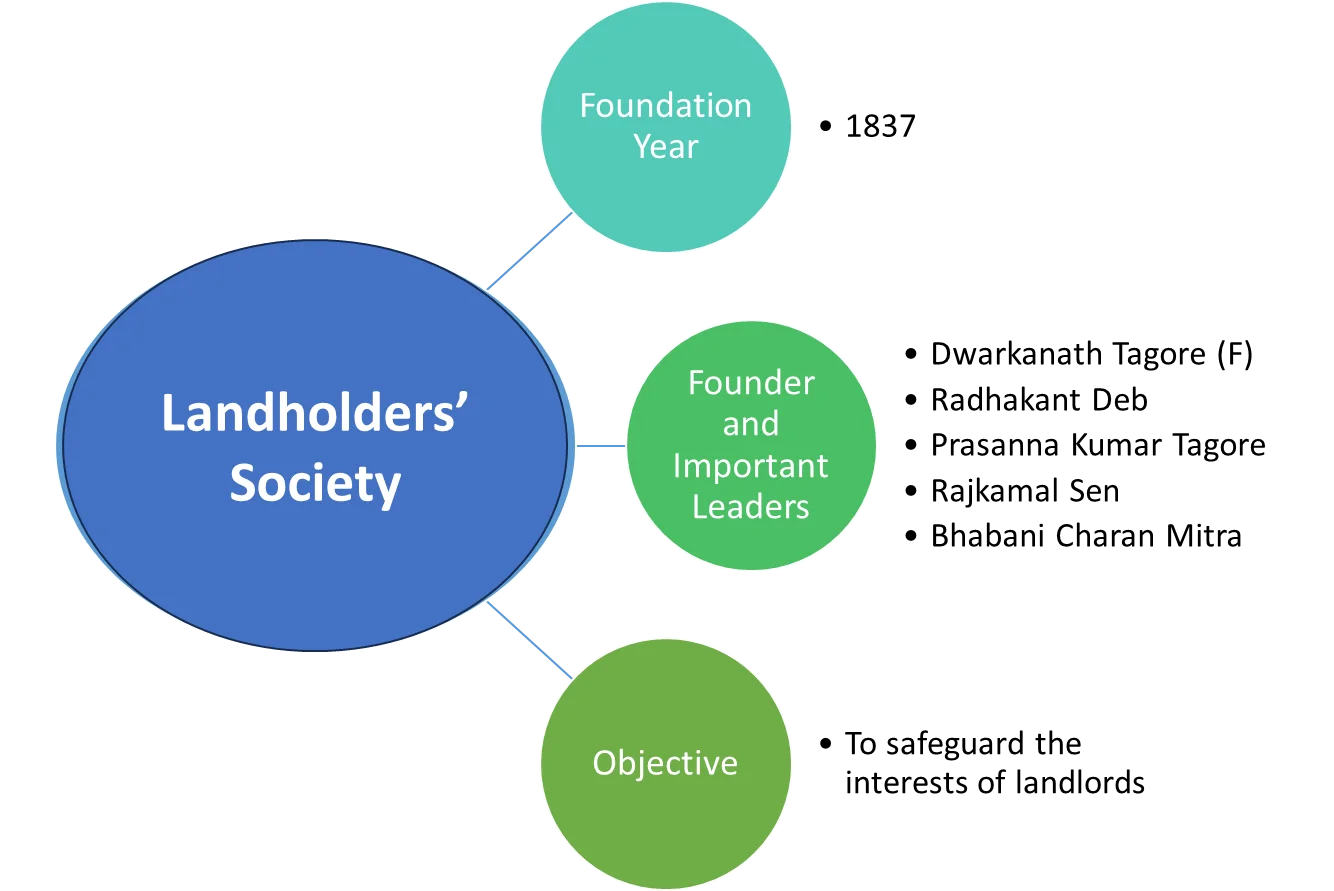
Objectives:
- To safeguard the interests of landlords.
- To initiate organized political activity.
- To lay the groundwork for constitutional agitation, providing a platform for addressing grievances.
- Its establishment marked a significant juncture in the political landscape, setting the stage for more extensive political engagement in the years to come.
Bengal British India Society
In 1843, the visionary George Thompson formed the Bengal British India Society with Dwarkanath Tagore, Chandra Mohan Chatterjee, and Parmananda Maitra.
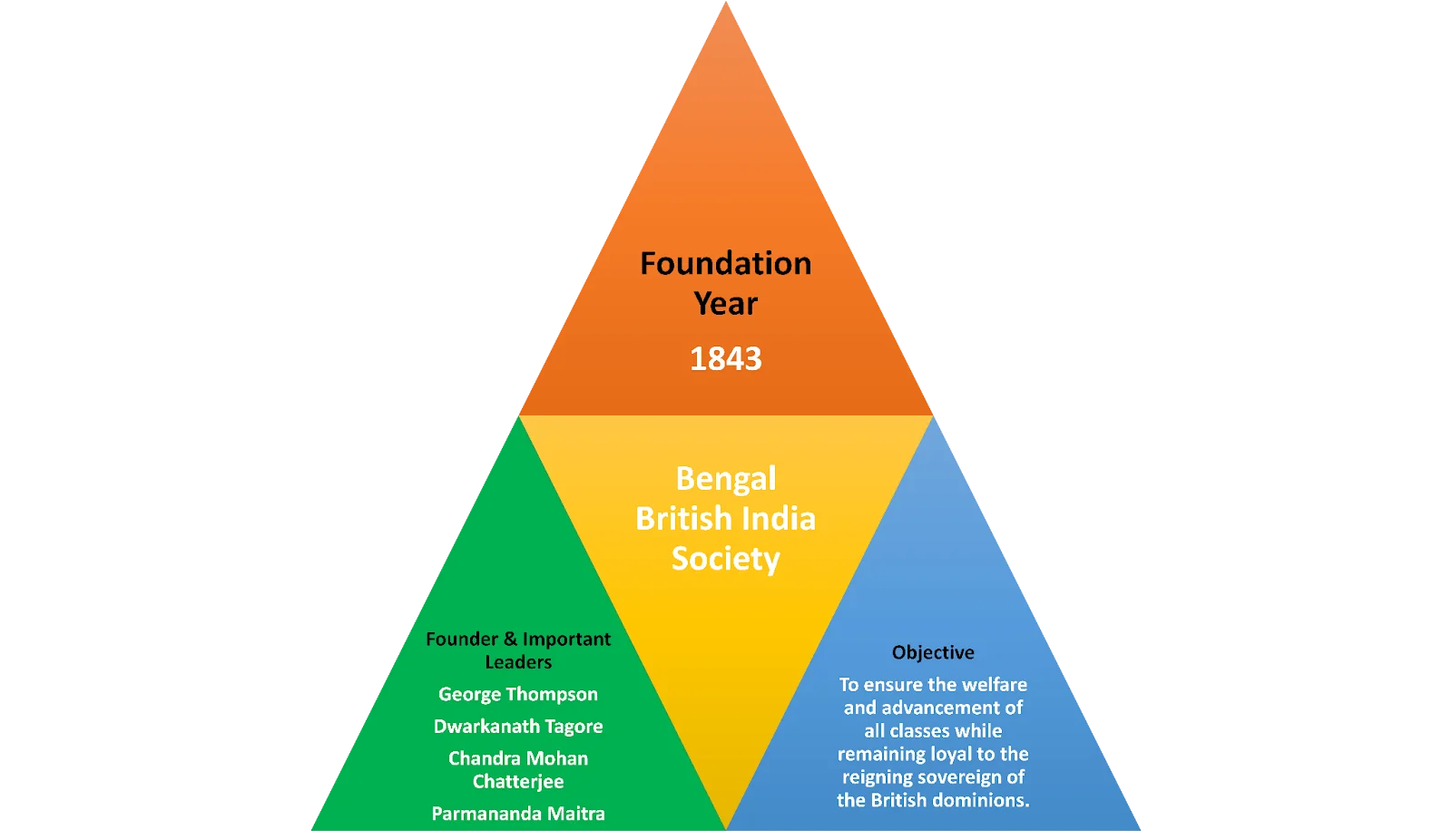
Objectives:
- It was established on purpose to gather information related to the welfare of people in British India.
- Promoting Good Citizenship: It is aimed at inculcating among the Indian people the qualities of good citizenship, not just in informing them.
- Advocating Enlightened Governance: It also aimed at enlightening the public on the state of governance so that they could bring about positive changes through legal and peaceful means.
- Fostering Colonial Cooperation: However, these initiatives were undertaken in an attempt to support the governing monarch of England and thus, promote cooperation and amiability within the colonial environment.
British Indian Association
In 1851, a significant development unfolded with the establishment of the British Indian Association, a merged entity comprising the Landholders’ Society and the Bengal British India Society. Under the leadership of Raja Radhakant Deb as President and Debendranath Tagore as Secretary, the Association became a formidable voice in articulating the concerns of the Indian populace.
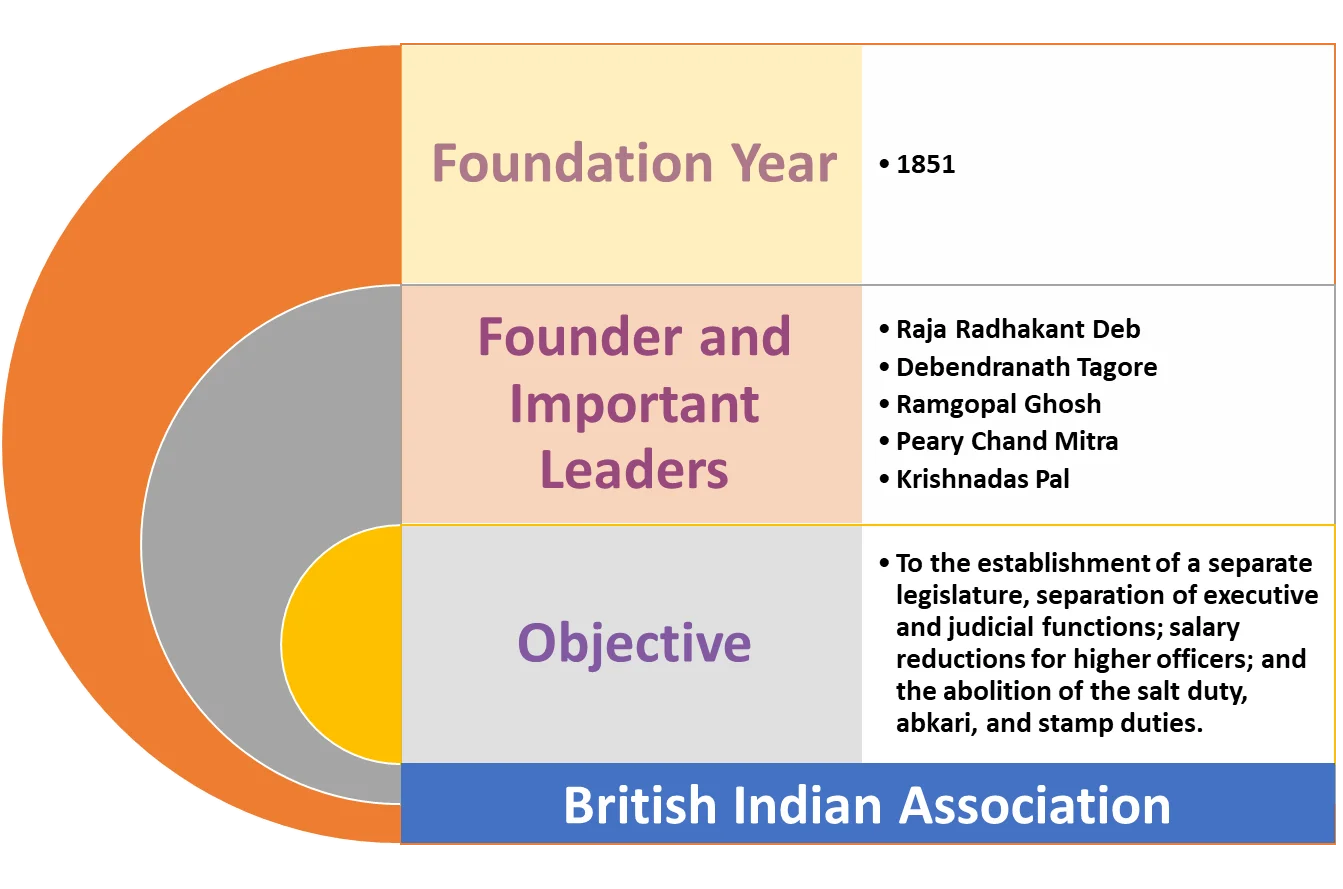
Objectives:
In 1853, the Association forwarded a comprehensive petition to the British Parliament, advocating for
- The establishment of a separate legislature,
- Separation of executive and judicial functions,
- Reduction in salaries of higher officers, and
- Abolition of salt duty, Abkari, and stamp duties.
While not all demands were fully met, the Charter Act of 1853 did partially address these concerns by incorporating provisions for the addition of six members to the governor-general’s council for legislative purposes. This marked a pivotal moment in the evolving political landscape, underscoring the influence and impact of the British Indian Association in shaping legislative reforms during this period.
National Indian Association (NIA)
The National Indian Association (NIA), founded in 1870 in Bristol, originally known as the ‘National Indian Association in Aid of Social Progress in India,‘ emerged under the visionary leadership of Mary Carpenter, with support from Keshab Chandra Sen.
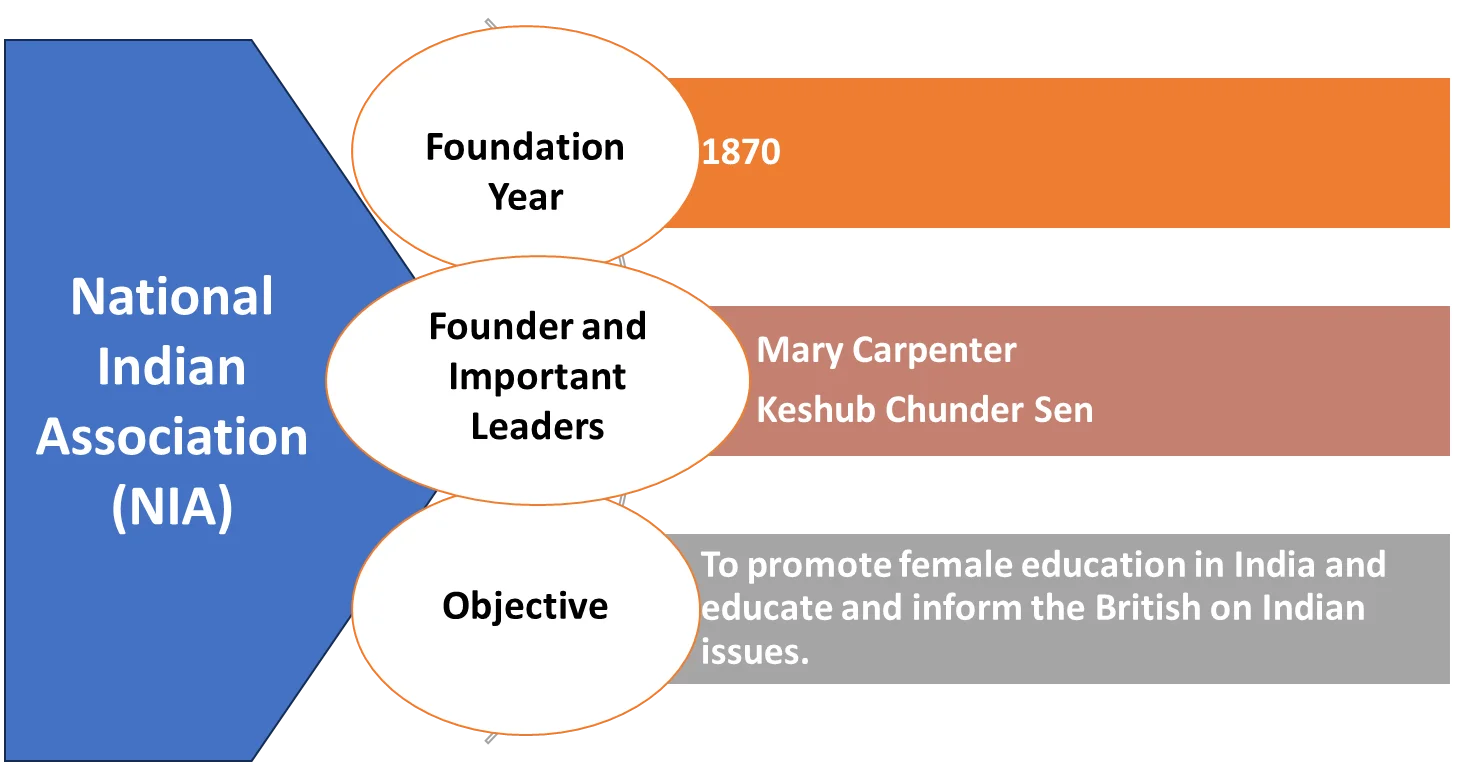
Objectives:
Mary Carpenter laid the foundation of this association with dual objectives –
- First and foremost, the association sought to advance female education in India, recognizing the pivotal role of education in societal progress.
- Additionally, it aimed to serve as an educational platform for the British, fostering awareness and understanding of pertinent Indian issues.
- The National Indian Association emerged as a bridge between cultures, embodying a commitment to social progress and cross-cultural enlightenment during this period.
Indian League
As early as the 1870s, there were indications of transformation inside Indian society. Higher education had flourished in the Presidential towns, and people entering new professions were achieving new goals and status. During this period, a new elite emerged in every presidency, with similar aspirations and social standing. This evolution cleared the path for the rise of broader associations, named as Indian league. Indian League was established in 1875 by Sisir Kumar Ghose with a clear vision and goal in mind with an objective:
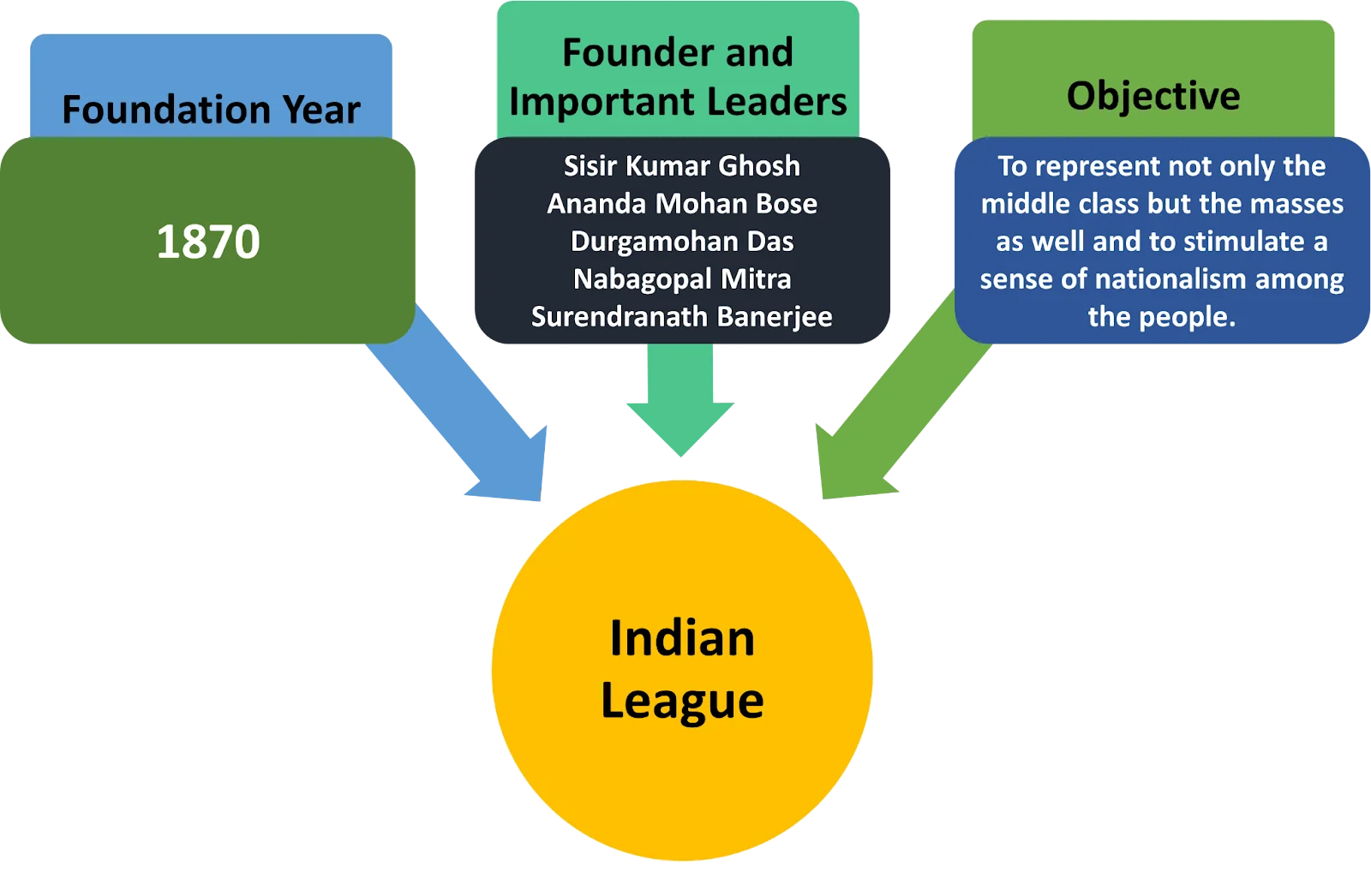
Objectives
- Expanding Political Representation: As the founder, Ghose steered the league towards a unique mission—to go beyond representing the middle class and extend political representation to the masses.
- Fostering Nationalism: The league’s objectives went further, seeking to kindle a collective sense of nationalism among the people, and of encouraging political education.
Sisir Kumar Ghose’s visionary leadership marked the Indian League as an inclusive and forward-thinking political association, breaking new ground in advocating for widespread representation and fostering a unified national identity during a crucial juncture in India’s political evolution.
The Indian Association of Calcutta
The Indian Association of Calcutta (superseded the Indian League) was established in 1876 in Calcutta and alternatively known as the ‘Indian National Association,’ bore the visionary imprint of its founders, Surendranath Banerjee and Ananda Mohan Bose. Dissatisfied with the conservative and pro-landlord stance of the British Indian Association, they envisioned the Indian Association as a potent platform to advance political, intellectual, and material progress.
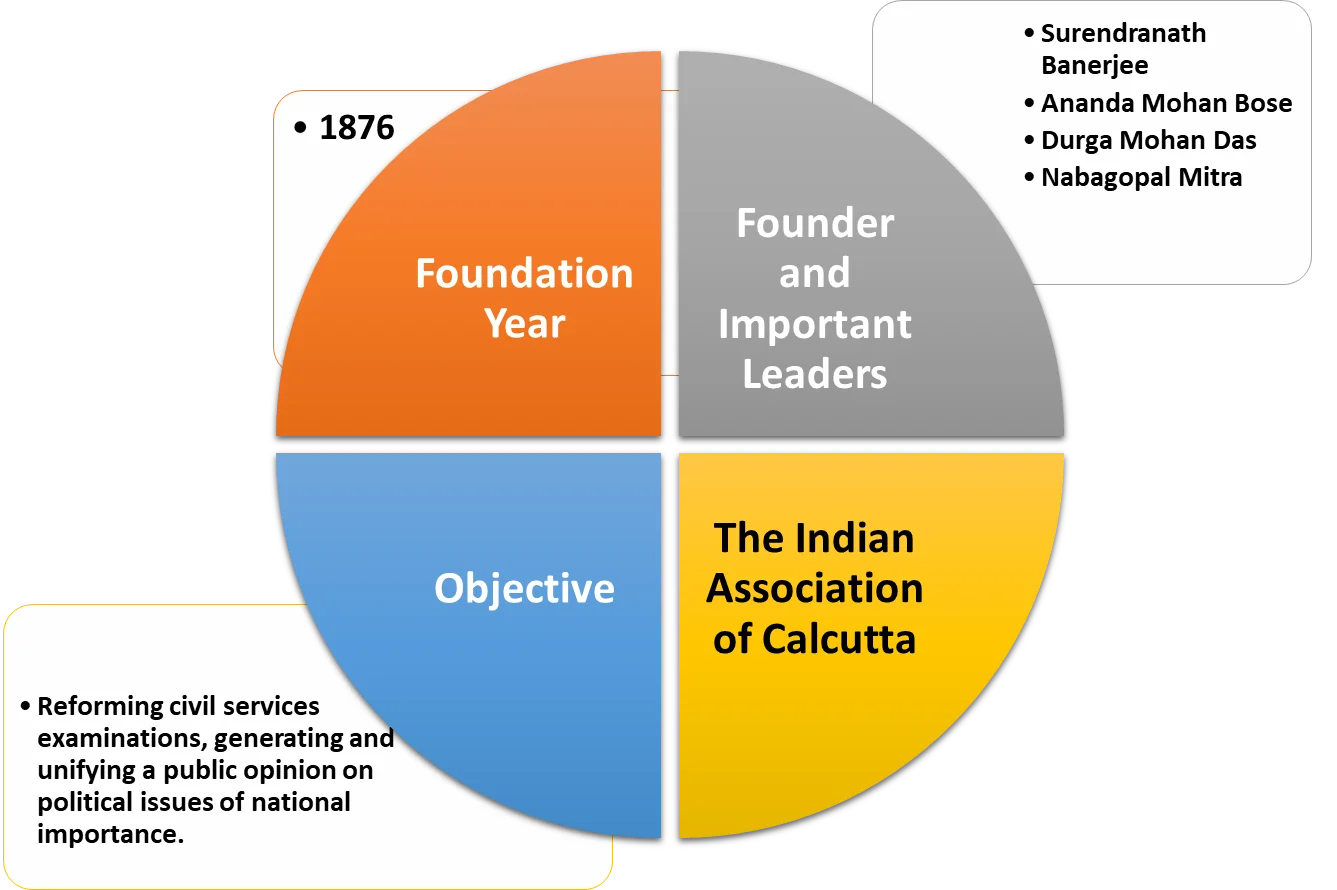
Objectives
- Pioneering Political Activism and Unity: This association stood at the forefront of political activism with a mandate to create a robust public opinion on political matters and to unify Indians under a common political program.
- Protest Against Discriminatory Policies: In 1877, it protested against the reduction of the age limit for candidates for the Indian Civil Service exam.
- Advocacy for Civil Service Reforms: It demanded simultaneous holding of civil service exams in England and India, Indianisation of higher administrative posts, and a campaign against repressive arms act and vernacular press act.
- Laying the Foundation for Nationalist Movements: The association’s significance further manifested in sponsoring an all-India conference in 1883, foreshadowing the Indian National Congress as an all-India nationalist organization.
|
Lytton’s controversial policies fueled political activism in India. In 1876, a regulation reduced the maximum age for the Indian Civil Service examination from 21 to 19 years, posing challenges for young Indians as the exam was held only in London. The Indian Association spearheaded a nationwide protest known as the Indian Civil Service Agitation against this measure. Surendranath Banerjee played a pivotal role, embarking on an extensive tour of northern India in May 1877. During his visits to various centers, new political organizations were established to collaborate with the Indian Association. |
It was a pivotal pre-Congress association (a forerunner of the Indian National Congress and later merged with INC in 1886), and established branches across Bengal and beyond. Keeping membership fees low aimed at inclusivity, particularly attracting the poor section.
| Must Read | |
| Current Affairs | Editorial Analysis |
| Upsc Notes | Upsc Blogs |
| NCERT Notes | Free Main Answer Writing |
Conclusion
The political associations preceding the Indian National Congress laid the groundwork for India’s national movement by introducing new political ideas and fostering unity across diverse social classes. These early organizations, from the Bangabhasha Prakasika Sabha to the Indian Association of Calcutta, advocated for administrative reforms, education, and civil rights, setting the stage for a broader national consciousness and the eventual rise of the Indian National Congress as a unifying force in India’s struggle for independence.
Sign up for the PWOnlyIAS Online Course by Physics Wallah and start your journey to IAS success today!
| Related Articles | |
| Indian National Congress: Formation, Important Sessions | Indian National Movement |
| European Union (EU) | British Policy in India |

 GS Foundation
GS Foundation Optional Course
Optional Course Combo Courses
Combo Courses Degree Program
Degree Program











